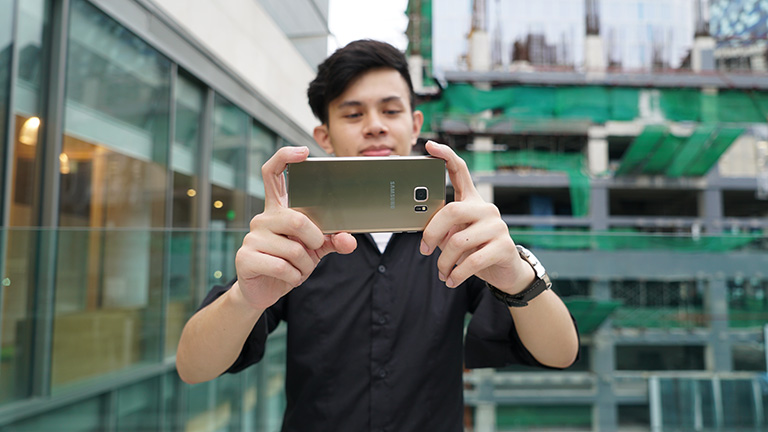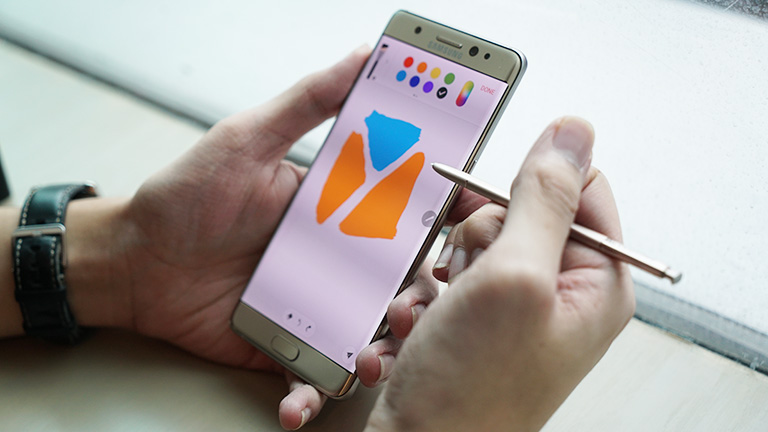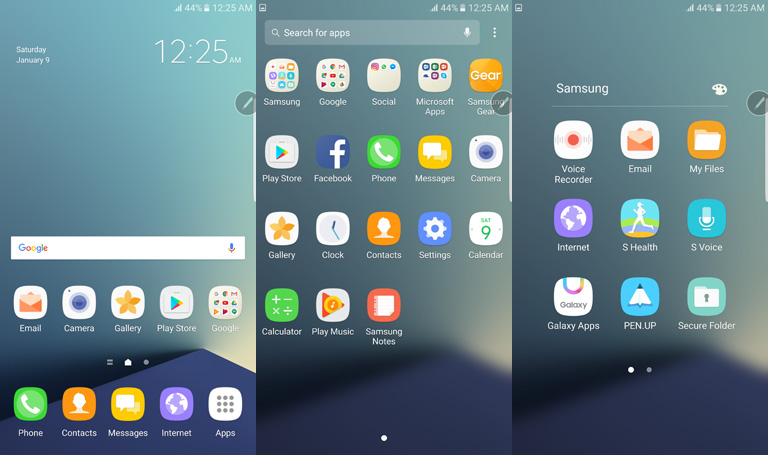Samsung’s first order of business when they announced this year’s Galaxy Note is to skip the 6 and go straight to Note 7. The reason being is that the Galaxy S series is currently in the 7th iteration and by naming this year’s phablet to Note 7, it gives a more cohesive naming scheme to the line-up.
This allows Samsung to give the impression that its entire flagship line-up is at par with each other. True enough, this year’s Galaxy Note 7 has the same exact design signature as the Galaxy S7 and S7 Edge and this extends to the core hardware of the smartphone.
Table of Contents
The Note 7 looked almost exactly as we expected it. Even the multiple leaks that came out before the announcement left nothing to the imagination. The design was predictable yet actually pretty refreshing. This is because the Note series has long been regarded as too big for a regular user with its 5.7-inch display. The Note 7 broke that perception and the first time we got our hands on the unit two weeks ago, we were very surprised it was that compact and manageable with one hand.

In fact, the Galaxy S6 Edge Plus (which also has a 5.7-inch display) is chunkier and the Galaxy S7 Edge is pretty much almost at par with the Note 7. Samsung managed to squeeze in that much screen real estate in a slightly smaller body. And since the edges of the display curves toward the sides, it further reduced the width of the device. It’s not a lot but still noticeable.

While the edges are curved, they’re not as pronounced as the Galaxy S7 Edge. While looking very similar to the S7 Edge, the profile is still distinct.

Compared to the previous two Galaxy Note releases, the Note7 is slightly thicker than the Note 5 in favor of a slimmer width which makes it more manageable with one-handed operation. It’s also the lightest of the three at 168 grams, though not that much.
The Note7 employs a stronger AL7000 series aluminum for the body, the same type of material that we first heard Apple uses for their iPhone 6S.
There will only be one storage variant and that’s 64GB although upon inspection available space is only 52.3GB and 571MB is allocated as reserved space. The internal storage is complemented by a microSD card slot that supports up to 256GB capacity.
The Note7 is now also IP68 rated, just like the S7 and S7 Edge, so expect the same extent of water-proofing.
Maintaining the 5.7-inch display size, Samsung uses the same Super AMOLED technology in the Note 7 with a quad HD resolution of 2560 x 1440 pixels giving it a pixel density of 534ppi. Just like the Galaxy S7 Edge, the Note 7 now has a dual edge screen although the curves are slightly less prominent.
This is also the first time we’re going to see Gorilla Glass 5 being used in a smartphone. Pretty interesting, considering Corning only officially announced Gorilla Glass 5 last July 21. Corning claims Gorilla Glass 5 can survive up to 1.6-meter or shoulder-height drops onto hard, rough surfaces up to 80% of the time. The glass at the back is still Gorilla Glass 4 though.

The screen also features a Blue Light filter (available via the drop down shortcut window) to help ease strain on the eyes especially when viewing the screen in the dark.
Samsung used the same exact camera in the Galaxy S7 with the Note 7: Same dual-pixel technology and HDR video tucked inside the 12MP rear sensor.
As such, we thought we didn’t have to dwell much further in this section except for some sample photos and videos as well as improvements in the native camera app of the device. Basically, all the settings have been hidden in swipes. Swipe to the left for the modes, to the right for the filters, and up and down to alternate between front & back cams.
Here are some sample shots taken with the Note 7:
The camera can also 4K video recording at 30fps. Here are some sample clips:
What’s actually a first in any smartphone is Mobile HDR Video, a technology currently being used in TV displays but certainly a first in any mobile device. HDR Video allows for higher contrast and wider range of colors. With content providers (Amazon and Netflix) already streaming HDR video, the Note7 will certainly benefit from it.

The native camera app has a few additional tricks up its sleeve but one of our favorite would be the event-driven slow motion capture.
The S Pen has always been one of the biggest selling points of the Galaxy Note series and they continue to develop it to make it better. The new S Pen on the Note7 is better with a 0.7mm pixel size, 70ms latency, 360Hz scan rate with 4,096 pressure levels. Screen write, Air Command and Magnify (up to 300%) is still there.

The device also features a built-in translate where you can just select a text or image and it can recognize the language (37) andf convert it to 71 other languages.
The device came with Android 6.0.1 Marshmallow right out of the box with Samsung’s TouchWiz UI layered on top. While there’s really not that much design improvement from the previous version, the focus was making the S Pen more useful and incorporating all of the Edge Panels into the Note 7.

The Always On Display now supports 3rd-party apps so you can see notifications from chat apps and messengers even if the screen is off. The same is true with music players — you can see what’s currently playing and even control playback from the off screen.

Aside from the Smart Select we first saw in the Note 5, the Note7 also feature Smart Video Select. This feature allows you to select a portion of the video and save it as an animated GIF which you can then post Facebook or Twitter.
The old S Note has been replaced with Samsung Notes (no more memo app, action memo, S Note and scrapbook) which is a more integrated shortcut menu for the S Pen. Again, there’s also a translator now for the S-Pen.
What hasn’t changed is the Edge functionality. You can peak through notifs while the screen is off, it lights up when new ones come and the phone is facing down, and the Edge Panels are basically the same. However, having the S-Pen and the Edge over to the side can be a little messy, so we just deactivated it after a while.

Overall, the Samsung software is now something that is really usable. All of their features are locked away in one setting tab, and overall, design & usability is top-notch considering all the features that they have to pack in. Also, I can hide more clutter away in the notification shade – something that I can’t do in my Galaxy S7.
There are also a couple more features that I weren’t able to find on my S7: the Blue Light Filter and the Video Enhancer. The Iris Scanner software also covers the basics, and it works incredibly well. However, the functionality is limited by software too as it stutters sometimes, and we’re not entirely sure if it is faster than just a fingerprint scan. It’s very useful however, for features like Samsung’s Secure Folder for apps – not for phone unlocking.
In this section, we note that the Note 7 uses the same exact Exynos 8890 chip as the Galaxy S7 and S7 Edge from earlier this year. Considering that they also have the same display resolution, we expect the Note 7 to perform as good.
Indeed, benchmark results showed scores within the range of the S7 and S7 Edge. Samsung also maintained the phone’s memory to 4GB which is more than good enough but many are expecting them to actually pack at least 6GB in there considering a lot of smartphones released earlier this year (Vivo Xplay 5 Elite, OnePlus 3, Asus Zenfone 3 Deluxe, ) already came with 6GB memory.
Benchmark Scores:
Overall, it has been pretty fast. It does stutter sometimes with excessive load while loading the Iris Scanner, but that’s it.
Call quality is good and voice calls are clear and crisp. The dual nano SIM tray supports LTE on both SIM with the second SIM able to handle up to 256GB of microSD card. There’s fast WiFi 802.11ac, Bluetooth and NFC. The Heart Rate sensor is also integrated into the rear LED flash of the device.
The physical home button of the Note7 also serves as the fingerprint sensor. It’s now faster, just like the ones in the S7 and S7 Edge. However, for extra security, Samung has also incorporated an Iris scanner which is another first for Samsung.
The Iris scanner takes a retinal scan of the user and use it to unlock the phone. The sensors are located at the top corner of the display. Based on our tests, the Iris scanner is very accurate and fast. We even tried using it in a dark room and it still managed to identify and scan our eyes.
The Note7 comes with a 3,500mAh internal battery which is about 17% higher than the Note5 although it’s still lower by 100mAh compared to the Galaxy S6 Edge+ and the S7 Edge (both have 3,600mAh). As expected, the Note 7 will have better battery life than the Note5 (clocked at 8 hours, 33 minutes in our PCMark Battery Test). The S7 Edge got a score of 9 hours, 50 minutes while the S6 Edge+ got 9 hours, 32 minutes. We believe the Note7 will get a score close to the 9.5-hour mark.

However, that assumption is wrong. It was much higher than the S7 Edge and the S6 Edge+, both of which with larger batteries. In our PCMark Battery Test, the Galaxy Note7 got 10 hours and 24 minutes. That is impressive.
In addition, the Note7 also comes with fast wired charging and fast wireless charging (Qi/PMA compatible by region). Samsung promises 95 minutes in wired and 140 minutes on wireless. That’s slightly longer than the Note5 but that’s because of the higher battery capacity.
The device now comes with a USB Type-C port, a first in any Samsung smartphone. Samsung is bundling a regular Type-C charge as well as a Type-C to micro USB adapter inside the box.
We also made a quick run-down video of the difference between the Galaxy Note7 vs the Galaxy Note5 as well as the Galaxy S7. Check them out below:
Samsung now has a very unified line-up with its flagship Galaxy series — the 5.2-inch S7, the 5.5-inch S7 Edge and the 5.7-inch Galaxy Note 7. All three looked almost the same with identical internal hardware. What separates the Note7 from the other two, aside from its display size, is the S Pen and the Iris scanner.
Samsung has finally found its identity and solidifying it the Galaxy Note7. The Galaxy Note7 is still the same great phone with the same fantastic features found across the entire flagship line-up. It’s a smart move which Samsung is heavily capitalizing on.
Now the interesting part is, there’s little space now for an S8 Edge, knowing that the Note series will be having the bigger screen and the Edge itself. Maybe next year, the S8 and the Note8 will be launched simultaneously.
The Samsung Galaxy Note7 will be launched in the Philippines on August 20 with a suggested retail price of Php39,990 and comes bundled with a free Gear VR. The Note7 will be available in Gold Platinum, Black Onyx and Silver Titanium, while the Blue version is said to be coming in Q4.
Samsung Galaxy Note 7 specs:
5.7-inch Super AMOLED Quad HD Curved Display @ 2560 x 1440 pixels, 534ppi
Corning Gorilla Glass 5
Samsung Exynos 8890 2.3GHz octa-core CPU
4 x 2.3GHz + 4 x 1.6GHz Cortex A53
Mali T-880 GPU
4GB LPDDR4 RAM
64GB internal storage
up to 256GB via microSD (uses SIM 2 slot)
Dual SIM (hybrid), dual LTE
WiFi 802.11ac
Bluetooth 4.2
NFC
GPS with aGPS, GLONASS
12MP Dual Pixel rear camera dual-tone, dual LED flash, f/1.7 aperture
HDR Video
5 megapixel front-facing camera with f/1.7 aperture
USB Type C
Iris Scanner
Fast Wireless Charging
Fingerprint Scanner
Heart-Rate Sensor
IP68 rating
153.5 x 73.9 x 7.9mm (dimensions)
169 grams (weight)
Android 6.0.1 Marshmallow with TouchWiz
3,500mAh Li-Ion non-removable battery
Gold Platinum, Onyx Black, Platinum Silver
What we liked about it:
* Great performance
* Impressive camera performance
* Great display quality
* Beautiful design
* Iris scanner is interesting
* Inclusion of a versatile stylus
What we did not like:
* Made more expensive than before
Editor’s Note: Bob Freking contributed to this review.

YugaTech.com is the largest and longest-running technology site in the Philippines. Originally established in October 2002, the site was transformed into a full-fledged technology platform in 2005.
How to transfer, withdraw money from PayPal to GCash
Prices of Starlink satellite in the Philippines
Install Google GBox to Huawei smartphones
Pag-IBIG MP2 online application
How to check PhilHealth contributions online
How to find your SIM card serial number
Globe, PLDT, Converge, Sky: Unli fiber internet plans compared
10 biggest games in the Google Play Store
LTO periodic medical exam for 10-year licenses
Netflix codes to unlock hidden TV shows, movies
Apple, Asus, Cherry Mobile, Huawei, LG, Nokia, Oppo, Samsung, Sony, Vivo, Xiaomi, Lenovo, Infinix Mobile, Pocophone, Honor, iPhone, OnePlus, Tecno, Realme, HTC, Gionee, Kata, IQ00, Redmi, Razer, CloudFone, Motorola, Panasonic, TCL, Wiko
Best Android smartphones between PHP 20,000 - 25,000
Smartphones under PHP 10,000 in the Philippines
Smartphones under PHP 12K Philippines
Best smartphones for kids under PHP 7,000
Smartphones under PHP 15,000 in the Philippines
Best Android smartphones between PHP 15,000 - 20,000
Smartphones under PHP 20,000 in the Philippines
Most affordable 5G phones in the Philippines under PHP 20K
5G smartphones in the Philippines under PHP 16K
Smartphone pricelist Philippines 2024
Smartphone pricelist Philippines 2023
Smartphone pricelist Philippines 2022
Smartphone pricelist Philippines 2021
Smartphone pricelist Philippines 2020
nexus says:
i think iris scanner is not first on samsung.. it was first on fujitsu arrows which is smartphones in japan, followed by lumia 950xl.. and since it is not “samsung”, people ignored it
Danny says:
Siguro hindi more expensive than before kasi may FREE DAW na GEAR VR, kung alisin nila yun free daw mas mura yun
Liame says:
Hi. Will smart and globe offer the same freebie (gear VR)? Won’t it be the 256GB sd card similar to the offer in the US?
And which gear VR will be free, the new version or the prior version?
Thanks!
kikoexe says:
i was hoping for a more detailed battery test as the note 7 is the first smartphone that allows users to change the resolution from QHD -> FHD -> HD on stock software.. this is definitely a godsend for power users who are contented on having a FHD resolution on a galaxy note.. i just hope they roll out this feature to at least the s7, s7 edge and note 5..
MCon says:
S7 has a 5.1″ screen and the s6 edge+ battery has the same 3000 mAh of the Note5.
ben says:
buti naman hindi sumabog yan sa mga kamay mo? :D